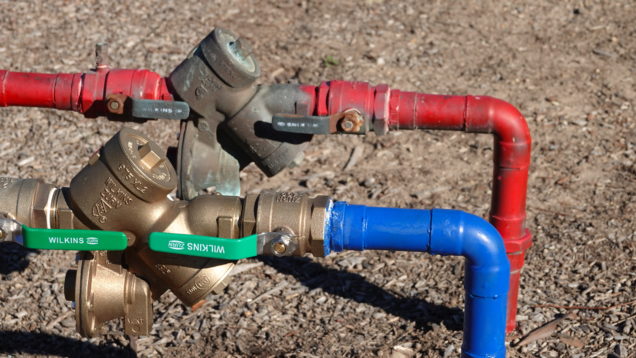We all know plumbing issues can become a stressful hazard for Indianapolis homeowners. But did you know they can be harmful to your health, too?
One of the most serious plumbing issues that can occur is when the flow of water reverses direction because of a change in pressure, leading to what is called backflow. Backflow can introduce contaminated water into a home’s clean water supply, such as bathing or drinking water, leading to the potential for serious health issues.
To prevent harmful polluted water from backing up into your home’s potable water supply, you may need to have a backflow prevention device installed. In our most recent blog, the plumbers at Mission Mechanical explain what backflow is, how a backflow prevention device works, and whether you might need one installed in your home.
What Is Backflow, and How Does It Occur?
Backflow can commonly occur due to a change in pressure between two different points in the plumbing system, which can include water of high pressure flowing to water of low pressure. If the water pressure drops dramatically due to a sudden increase in the withdrawal rate, backflow issues can occur and cause water to flow in reverse.
This can cause the clean potable water to mix with dirty, used, and even contaminated water that contains waste and other harmful contaminants. This is a major health risk for your family members. Contaminants that can back up into a home’s potable water supply include:
- Human waste
- Pesticides and fertilizers
- Soap from sinks, showers and dishwashers
There are two common causes of backflow: backpressure and back-siphonage.
- Back siphonage occurs when there is a significant loss of pressure in a home’s potable water supply, causing backflow to reverse into the clean water supply. Back siphonage can commonly occur because of firefighters’ use of a fire hydrant or a nearby burst pipe.
- Back pressure, meanwhile, typically occurs when the pressure of the contaminated water becomes greater than the potable water supply. This is typically caused by sprinkler systems or boilers. When contaminants flow back through the sprinkler head, they can introduce fertilizer and pesticides into potable water.
Why You Might Need a Backflow Preventer
A reduced pressure backflow preventer is installed in your water pipes to ensure water flows in only one direction to prevent cross-contamination risks. Backflow valves are required in commercial buildings and generally in residences that are connected to a water-powered sump pump or an irrigation system.
A backflow valve prevents infected water from mixing with a home’s potable water supply. If there’s a sudden drop in water pressure, the backflow valve will open up and prevent water from flowing backward into the main supply of water.
Backflow valves aren’t required in all homes, but some municipalities require them if your home has an irrigation system, for example. In some cases, though, it’s definitely worth having one installed even if they’re not required. The plumbers at Mission Mechanical can assess your property and recommend whether a backflow valve should be installed.
Some of the main benefits of having a backflow valve installed in your home include:
- Preventing backflow from contaminating your home’s clean supply of water to ensure healthy water for drinking, cooking and cleaning.
- Eliminating health issues associated with family members drinking or bathing in water that has been contaminated.
- Complying with local governments in the case a backflow valve is required for your home.
- Preventing damage to pipes when foreign materials flow through them.
Contact Mission Mechanical for the Installation of a Backflow Valve
If you’re unsure if your home is required to have a backflow prevention device installed or could benefit from one, contact the licensed plumbers at Mission Mechanical. We will assess your property and help you make an educated decision in regards to whether you need a backflow valve installed or not. Contact Mission Mechanical today to request an appointment or to receive more information on backflow prevention devices.




